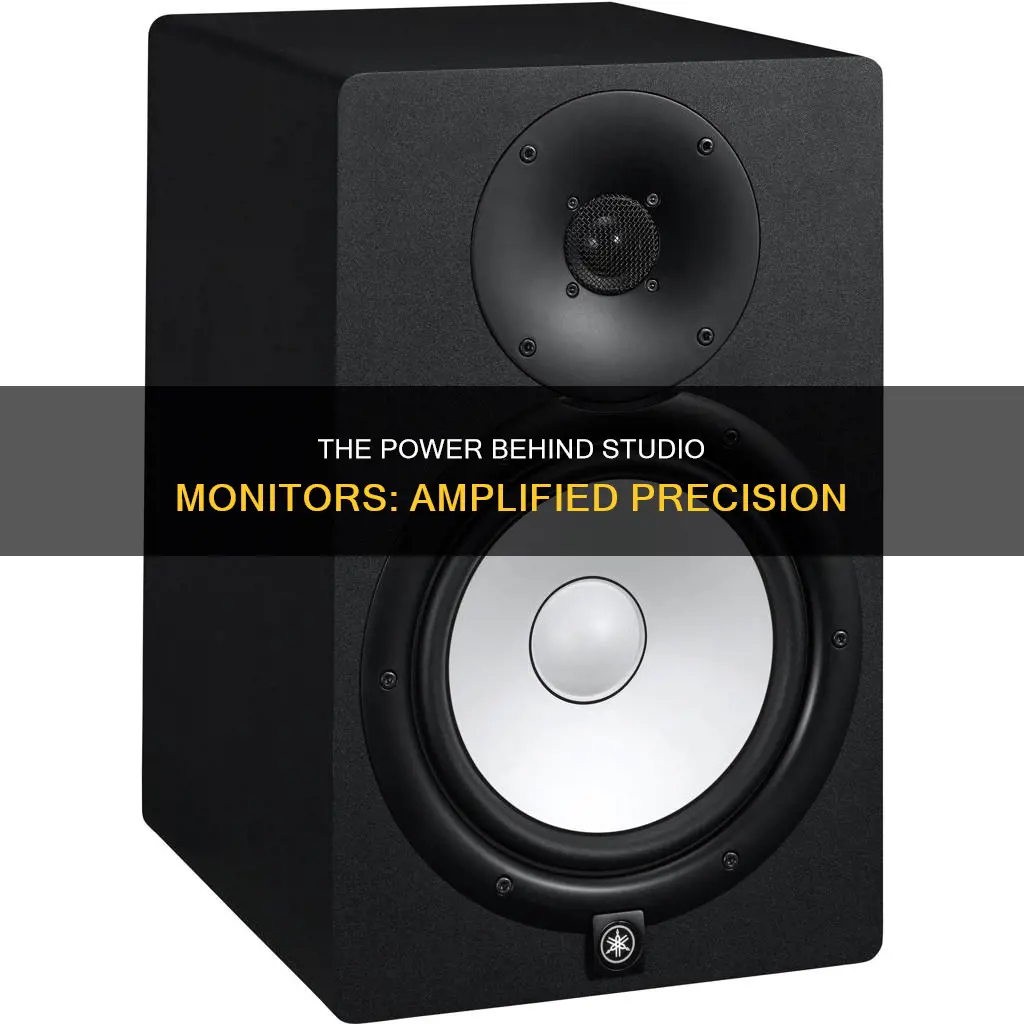
Studio monitors are speakers used in the recording, mixing, and mastering process. They are designed to reproduce sound accurately, allowing users to identify and fix sonic imperfections. Studio monitors can be active or passive. Active monitors have built-in amplifiers, while passive monitors require external amplifiers. Active monitors are more convenient and offer better sound quality since their built-in amplifiers are specifically designed for the speakers. However, passive monitors offer more flexibility as users can choose external amplifiers that best match their needs. When choosing studio monitors, factors such as room size, music style, and budget should be considered to ensure optimal sound quality and performance.
What You'll Learn

Active vs. Passive Monitors
Studio monitors are an essential component of any recording setup, providing accurate sound reproduction for critical listening and mixing. When it comes to choosing between active and passive studio monitors, there are several factors to consider. Let's delve into the details of each type and explore the advantages they offer.
Active studio monitors feature built-in amplifiers, making them a convenient plug-and-play option. They are simple to set up and use, as they do not require any additional equipment beyond power and audio cables. The built-in amplifiers are specifically designed for the monitors, often resulting in better overall sound quality. Active monitors are typically heavier due to the integrated amplifier and require a power outlet for each speaker. They are an excellent choice for those seeking a reliable and accurate monitoring solution without the need for external amplification.
On the other hand, passive studio monitors require an external amplifier to function. This adds a layer of complexity to the setup process, as you need to ensure the amplifier matches the power rating and impedance of the monitors. However, this external amplification offers greater flexibility in creating your ideal signal chain. You can choose amplifiers, crossover systems, and processors that suit your specific needs, allowing for a highly customised setup. Passive monitors are generally lighter and only require a standard speaker cable, making them easier to mount on walls or ceilings.
Both active and passive monitors have their advantages, and the choice depends on your specific requirements. If you prioritise convenience and ease of use, active monitors are a suitable option. On the other hand, if customisation and flexibility are important to you, passive monitors might be preferable. It's worth noting that the quality of the monitors themselves is a more significant factor in achieving professional sound than whether they are active or passive.
LCD Monitors: Alienware's Immersive Gaming Experience
You may want to see also

Power and Wattage
Studio monitors require power to function, and this power is measured in watts. The power handling of a studio monitoring system will have a significant effect on the overall sound, not just in terms of volume but also in terms of dynamic range and headroom.
Active vs Passive Monitors
Studio monitors can be either active or passive. Active monitors have built-in power amplifiers, while passive monitors receive power from a dedicated standalone amplifier. Active monitors are simpler to use and more convenient, while passive monitors offer more flexibility.
Power Handling
The power handling of a studio monitoring system, measured in watts, will impact the overall sound quality, volume, dynamic range, and headroom. Higher wattage means you'll be able to hear more transient detail and make more precise adjustments to compressors, limiters, and gates. It's important to note that more wattage will produce more definition and dynamic range, not just overall volume.
Wattage Considerations
When choosing the wattage of your studio monitors, consider the size of the room and the type of music you'll be working with. For beginners or small-to-medium-sized rooms, 50-75 watts per channel is a good starting point. For larger commercial studios, you may need 100 watts or more per channel. However, it's not just about the wattage; quality is also important. A well-designed, high-quality studio monitor with lower wattage can often sound better than a cheaper one with higher wattage.
Amplifier Configurations
There are several amplifier configurations available for studio monitors: single-amp, bi-amp, and tri-amp. These configurations determine how the input signal is divided to power the drivers in the monitor. Bi-amp and tri-amp configurations are commonly used in professional studios and offer greater control over the frequency response, providing a flatter and more accurate sound with greater definition.
Simple Guide: Monitor Attachment for 484 New Ideal Balers
You may want to see also

Amplifier Configurations
When it comes to amplifier configurations for studio monitors, there are three main options: single-amp, bi-amp, and tri-amp. Each configuration offers different benefits and is better suited to different types of setups.
The single-amp configuration is the simplest setup, typically used for active studio monitors. In this configuration, the left and right speakers are powered by a single amplifier, usually integrated into one of the speakers. This setup is rarely used for studio monitors but is common for computer speakers.
The bi-amp configuration, on the other hand, offers greater control over the frequency response and more precise sound reproduction. In this setup, each driver has its own dedicated amplifier, allowing for more accurate and detailed sound. Bi-amp configurations are often used in professional studios where accuracy and precision are crucial.
The tri-amp configuration is the most advanced and complex of the three. In this setup, each driver in a 3-way speaker system (woofer, midrange, and tweeter) has its own dedicated amplifier. This provides the ultimate control over the frequency response and allows for the most precise sound reproduction. Tri-amp configurations are typically found in high-end professional studios where the highest level of accuracy is required.
The choice between these amplifier configurations depends on the specific needs and requirements of the user. While single-amp configurations offer a simple and cost-effective solution, bi-amp and tri-amp configurations provide more advanced features and are better suited for critical listening and professional applications.
Monitoring CPU Temp and Usage: A Comprehensive Guide
You may want to see also

Driver Types
Studio monitors are typically made up of two separate drivers or speakers. The higher one, the tweeter, is responsible for producing high frequencies, and is often cone- or dome-shaped. The other speaker, the woofer, is placed below the tweeter and handles low and mid-range frequencies. Some monitors also have a third driver, a mid-range speaker, which produces mid-range frequencies, leaving the tweeter to produce high frequencies and the woofer to produce low frequencies.
The size of the studio monitor driver depends on the room size and the type of music being produced. For example, an EDM music producer will require a better low-frequency response and a bigger driver size. On the other hand, smaller speakers may offer better mid-range and high-frequency responses as they can reproduce these frequencies more accurately.
There are two types of monitor systems: passive and active. Passive monitors require an external amplifier to amplify the input signal before it enters the monitor. The amplified signal then passes through a crossover network, which acts as a filter, separating the input signal into multiple signals based on frequency. Active monitors, on the other hand, have built-in amplifiers, and the input signal passes through the crossover network first, after which each band is separately amplified.
In terms of amplifier configurations, there are three options: single-amp, bi-amp, and tri-amp. Single-amp is the simplest setup, where the left and right speakers are powered by a single amplifier. Bi-amp configurations have two amplifier modules in each speaker, providing greater control over the frequency response. Tri-amp configurations are the most advanced, with each driver having its own dedicated amplifier, allowing for the most precise sound reproduction.
Setting Up Elgato: A Guide to Monitor Connection
You may want to see also

Cabinet Considerations
When choosing studio monitors, there are several cabinet considerations to keep in mind. Firstly, the size of the monitors should be appropriate for the size of the room. Smaller monitors are typically better suited for smaller spaces, as they provide more accurate results. Additionally, the placement of the monitors is crucial. They should be positioned to form an equilateral triangle with the listener's head when seated, ensuring the most accurate frequency response and clearest stereo image.
Another important aspect is the type of cabinet, namely whether it is ported or closed. Ported cabinets have ports that help extend the frequency response lower for more bass. However, the sonic accuracy of ported cabinets may not be as precise as closed cabinets, especially if the ports are at the back and placed too close to a wall. For more accurate monitoring, consider front-ported or closed cabinet designs.
The power configuration of the monitors is also a factor to consider. Active monitors have built-in amplifiers, making them convenient and easy to set up. Passive monitors, on the other hand, require external amplifiers and offer more flexibility in amplifier choice. The number of amplifiers can vary, with single-amp, bi-amp, and tri-amp configurations available. Bi-amp and tri-amp configurations are often preferred in professional studios as they provide a flatter frequency response and greater definition.
Updating ASUS Monitor Drivers: A Simple Step-by-Step Guide
You may want to see also
Frequently asked questions
Active studio monitors have built-in amplifiers, meaning they don't require external power. Passive monitors, on the other hand, require an external power amplifier and are generally passive, receiving power from a dedicated standalone amplifier.
Active monitors offer a plug-and-play solution that is reliable and accurate. They are simple to set up and don't require additional equipment, making them a convenient and high-performance option.
The wattage you need depends on the size of your room and the dynamic range you want. Higher wattage provides more headroom, allowing you to hear more transient details and make precise adjustments. For a small to medium-sized room, 50-75 watts per channel is a good starting point.







